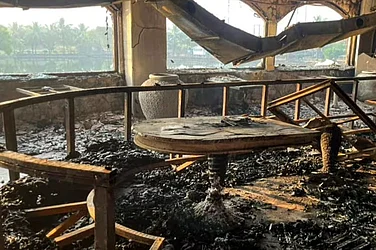How does Artificial Intelligence (AI) understand and interpret gender? That was the question on artist Karthik Kalyanaraman’s mind when he collaborated with his brother and AI to embark on an interpersonal journey to create “Strange Genders”. The human conception of gender identities more than often flows in the conventional representation of the male-female binary. AI, however, invisibilises the binaries. Speaking at a discussion about museums in the run-up to the second edition of the Bihar Museum Biennale, Kalyanaraman said, “When AI draws a human figure, there is only a certain percentage of a boy or girl in that image. The ‘strange gender’ in our art thus refers to the male and female.”
Be it in gender or in the art and intellectual world, the idea of fighting the binary permeated through the discussions, which was anchored by Outlook in collaboration with the Bihar Museum and held at the NGMA Bengaluru on July 8. The Bihar Biennale attempted to envisage museums beyond binaries, creating a space for not just museums made of brick and mortar, but also accommodated the museums we carry within us in the form of memories and experiences irrespective of our identities. And the discussions lent a small preview into what can be expected from the museums of the future.
The idea of a museum biennale was meant to challenge the definition of museums and museum management while transforming the intimidating stillness of these vast spaces into a volley of voices, and to enable a dialogue with the living museums within us. The larger objective was to act as a catalyst for decentralising power hierarchies and binaries. With two invigorating panels, moderated by Outlook India editor Chinki Sinha, the discussions and performances looked at museums and preservations through a neuroqueer’s lens and also highlighted the amalgamation of technology and art as a way to break normative binaries.
“Our focus is not just on buildings and collections, but on the common people and engaging with them,” said Anjani Kumar Singh, nodal officer of the Bihar Museum, while describing the biennale as a bridge to fill the void. The event was also a microcosm of Bihar itself and its rich heritage and contribution to Indian art. Be it through food, music or the flavour of the discussions, Bihar was reimagined within the four walls of NGMA Bengaluru.

The first panel at NGMA deliberated on the role of museums in a digital world as sites for community engagement and power negotiation. Against the backdrop of shifting demographics and ever-escalating technologies, moderator Chinki Sinha engaged with Nazneen Banu, Anjani Kumar Singh, Shreyasi Pathak, Basav Biradar, Karthik Kalyanaraman, and Tejshvi Jain to create a dialogue on the expansion, increasing connect and human engagement of technology.
Technology becomes an enabler of experiences beyond imagination. Exhibits can come to life, bridging the gap between the tangible and the intangible. With the aid of augmented reality and interactive displays, museums can transport its visitors to unexplored realms, where the boundaries between reality and imagination are blurred. “The Undivided Identities: Unknown Stories of Partition” project by Tejshvi Jain from ReReeti organisation was built along these lines.
The immersive exhibition aimed to uncover how, during the partition, non-Muslims from Sindh in Pakistan migrated and settled down in different states of India, including Bengaluru. “Our main focus was on how to make history relevant to students. The journey started with localising the experience to Bengaluru. It is all about choice based the narrative. The students were put in the shoes of a partition survivor to see what they went through,” she says, adding that children are an important part of museums.
But a question lingered among the audience and the panelists from art and academia like an unanswered riddle: “How do we truly see when we are forbidden to touch?” Children and most people are often warned to “not touch” anything in a museum. “We have technology to recreate that tactile feeling, and allow us to see what we can’t. It also allows the diversity of viewing—museums cannot be limited to viewing for just successful people,” says historian Basav Biradar.
Recapitulating the panel’s views, Anjani Kumar Singh says that Bihar Museum emphasises the experience of “feel and touch”. The museum has a section where audiences can touch the objects on display. Describing one such interactive model that can show the audience how to mint a coin, he says that the viewer becomes very satisfied with the result as they become a part of the process.
Attended by Mugdha Sinha, Tanishka Kachru, Arundhati Ghosh, Ravinder Reddy and Suresh Jayaram, the second panel looked at diversifying museums from the lens of gender and inclusion in terms of representing women and the neuroqueer community, with a focus on improvising display, collections and exhibits in a museum space. To engage with technology and redefine representation in a nation as diverse as India and their incorporation in policy emerged as an important theme during the Bihar Biennale event at NGMA Bengaluru.
On the representation of the queer community, Suresh Jayaram, founder of 1ShanthiRoad in Bengaluru, says that queerness and other diverse sexualities have never been given enough space in institutional spaces. His own abode, 1ShanthiRoad, was turned into an independently-run space for queer artists in the country, whom it supports via exhibitions and film screenings, among other ways.
D’Souza and Pathak’s ‘Resting Museums’ rejects the popular notion where the concept of rest has been amiss in museums, art and history. Pathak uses the ubiquitous examples of lighting and chair, which in their ordinary forms can become exclusionary for the disabled and neurodivergent communities. They further state that when one doesn’t simply have the energy or bandwidth to focus in a space designed for “abled bodies and minds”, it becomes important to think of ways where the “crip”, neuroqueer community cannot just experience, but also enjoy museums.
A specially curated culinary feast by chef Samta Gupta featuring ‘food from homeland’ reasserted Bihar’s history, culture and traditions at the event. The aroma of litti chokha, Champaran mutton, aaloo kebabi laid on banana leaves, gamchha (cotton towel) and teracotta dishes testified to the rich and diverse practices of Bihar. Samta’s meticulously curated menu was not just a culinary delight, but also a testament to the rich tastes of her home state, one that is both familiar and unknown.
Lata Mangeshkar Swar Kokila awardee, Neetu Singh Nutan performed at the event with the aim to change the conception of Bihar and revive its glorious history. After she charmed her audience by singing Chhath songs and Bhikhari Thakur’s ‘Bidesiya’, she highlighted the present crisis faced by Bihari folk music due to popular lewd songs and videos. The ‘Daughter of Champaran’ says that real music is one that unites families, societies, nations and the world. “Such a formidable force lies within the realm of folk music which is deeply rooted in our culture. YouTube is filled with music that might not align with our cultural heritage, but it gets millions of views which poses a formidable challenge for traditional folk artists. Our children need to be taught that this is real music. And it can take you places.” Bahuroopi Publications Co-Founder Sreeja V N says the event can be a starting point for those who are yet to experience and understand Bihar from beyond its popular narrative.
(This appeared in the print as 'Beyond The Binaries')


























